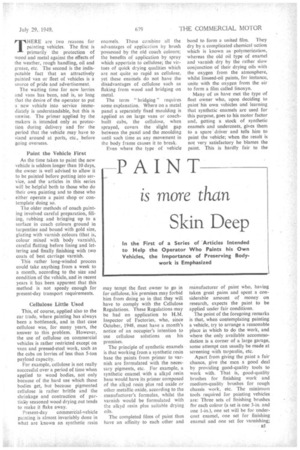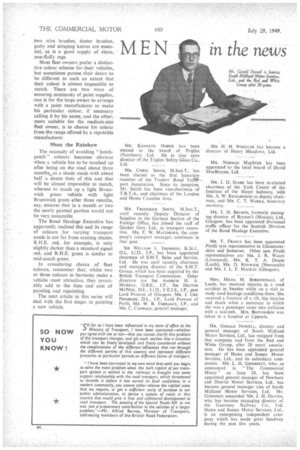PAINT is more than Skin Deep
Page 13

Page 14

If you've noticed an error in this article please click here to report it so we can fix it.
THERE are two reasons for painting vehicles. The first is primarily the protection of wood and metal against the effects of the weather, rough handling, oil and grease, etc. The second is the indisputable fact that an attractively painted van or fleet of vehicles is a source of pride and advertisement.
The waiting time for new lorries and vans has been, and is, so long that the desire of the operator to put a • new vehicle into service immediately is understandable, but this is unwise. The primer applied by the makers is intended only as protection during delivery and for the period that the vehicle may have to stand around at ports, etc., before going overseas.
Paint the Vehicle First As the time taken to paint the new vehicle is seldom longer than 10 days, the owner is well advised to allow it to be painted before putting into service, and the articles in this series will be helpful both to those who do their own painting and to those who either operate a paint shop or contemplate doing so.
The older methods of coach painting involved careful preparation, filling, rubbing and bringing up to a surface in coach colours ground in turpentine and bound with gold size, glazing with varnish colours (that is, colour mixed with body varnish), careful flatting before lining and lettering and finally finishing with two coats of best carriage varnish.
This rather long-winded process could take anything from a week to a month, according to the size and condition of the vehicle, and in recent years it has been apparent that this method is not speedy enough for present-day transport requirements.
Cellulose Little Used This, of course, applied also to the car trade, where painting has always been a bottleneck, and in that case cellulose was, for many years, the answer to this problem. However, the use of cellulose on commercial vehicles is rather restricted except on vans and pressed-steel work, such as the cabs on lorries of less than 5-ton payload capacity.
For example, cellulose is not really successful over a period of time when applied to wood bodies, not only because of the hard use which these bodies get, but because pigmented cellulose is rather brittle and the shrinkage and contraction of partial.ly seasoned wood drying out tends to make it flake away.
Present-day commerCial-vehicle painting is almost invariably done in what are known an synthetic resin
enamels. These combine all the advantages of application by brush possessed by the old coach colours; the benefits of application by spray which appertain to cellulose; the virtues of quick drying qualities which are not quite. so rapid as cellulose, yet these enamels do not have the disadvantages of cellulose such as flaking from wood and bridging on metal.
The term, " bridging " requires some explanation. Where on a metal panel a separately fixed moulding is applied as on large vans or coachbuilt cabs, the cellulose, when sprayed, covers the slight gap between the panel and the moulding until such time as any movement in the body frame causes it to break.
Even where the type of vehicle
may tempt the fleet owner to go in for cellulose, his premises may forbid him from doing so in that they will have to comply with the Cellulose Regulations. These Regulations may be had on application to H.M. Inspector of Factories, who, since October, 1948, must have a month's notice of an occupier's intention to use cellulose solutions on his premises.
The principle of synthetic enamels is that working from a synthetic resin base the paints from primer to varnish are formulated with the necessary pigments, etc. For example, a synthetic enamel with a alkyd resin base would have its primer composed of the alkyd resin plus red oxide or other metallic oxide, according to the manufacturer's formulas, whilst the varnish would be formulated with the alkyd resin plus suitable drying oils.
The completed films of paint thus have an affinity to each other and bond to form a united film. They dry by a complicated chemical action which is known as polymerization, -whereas the old oil type of enamel and varnish dry by the rather slow conjunction of their drying oils with the oxygen from the atmosphere, whilst linseed-oil paints, for instance, unite with the oxygen from the air to form a film called linoxyn.
Many of us have met the type of fleet owner who, upon deciding to paint' his own vehicles and learning that synthetic enamels are used for this purpose, goes to his motor factor and, getting a stock of synthetic enamels and undercoats, gives them to a spare driver and tells him to paint the vehicle; when the result is not very satisfactory he blames the paint. This is hardly fair to the manufacturer of paint who, having taken great pains and spent a considerable amount of money on research, expects the paint to be applied under fair conditions.
The point of the foregoing remarks is that, when contemplating painting a vehicle, try to arrange a reasonable place in which to do the work, and where the only available accommodation is a corner of a large garage, some attempt can usually be made at screening with tarpaulin, etc.
Apart from giving the paint a fair chance, give the men a good deal by providing good-quality tools to work with. That is, good-quality brushes for finishing work and medium-quality brushes for rough chassis work, etc. The minimum tools required for painting vehicles are: Three sets of finishing brushes for each colour (a set is one 3-in, and one 1-in.), one set will be for undercoat enamel, one set for finishing enamel and one set for varnishing; two wire brushes, duster brushes, putty and scraping knives are essential, as is a good supply of clean, non-fluffy rags.
Most fleet owners prefer a distinctive colour scheme for their vehicles, but sometimes pursue their desire to be different to such an extent that their colour is almost impossible to match. There are two ways of ensuring continuity of paint supplies, one is for the large owner to arrange with a paint manufacturer to make his particular colour, if necessary calling it by his name, and the other, more suitable for the medium-size fleet owner, is to choose his colour from the range offered by a reputable manufacturer.
Shun the Rainbow
The necessity of avoiding "hotchpotch " colours becomes obvious When a vehicle has to be touched up after being on the road about three months,as a shade made with about half a dozen tints of this and that will be almost impossible to match, whereas to touch up a light Brunswick green vehicle with light Brunswick green after three months, say, ensures that in a month or two the newly painted portion would not be very noticeable.
The Road Haulage Executive has apparently realized this and its range of colours for varying transport needs is not far from existing shades. R.H.E. red, for example, is only slightly darker than a standard signal red, and R.H.E. green is similar to mid-coach green.
In considering choice of fleet colours, remember that, whilst two or three colours in harmony make a vehicle most attractive, they invariably add to the time and cost of painting and repainting.
The next article in this series will deal with the first stages in painting a new vehicle.
MR. KENNETH HORNE has been elected to the board of Triplex (Northern), Ltd. He is also sales director of the Triplex Safety Glass Co., Ltd.
MR. C HRIS. SMITH, Minst.T., has been elected as the first honorary member of the Traders' Road Trail,. port Association. Since its inception, Mr. Smith has been vice-chairman of T.R.T.A., and chairman of the London and Home Counties Area.
MR. FREDERICK SMITH, M
until recently Deputy Director of Supplies in the German Section of the Foreign Office, has joined the staff of Quaker Oats, Ltd., as transport executive. MR. E. W. MATTHEWS, the company's transport manager, continues in that post.
SIR WILLIAM J. THOMSON, K.St.J., D.L. LI.D., J.P. has been appointed chairman of S.M.T. Sales and Service, Ltd. He was until recently chairman and managing director of the S.M.T. Group, which has been acquired by the British Transport Commission. Other directors are SIR ANDREW H. A. MURRAY, 0.B.E., J.P., SIR HECTOR McNEIL, Di., Ll.D., F.E.I.S.. J.P., past Lord Provost of Glasgow, MR. J. URE PRIMROSE, D.L., LP., Lord Provost of Perth, M. W. B. TORRANCE, LP., and MR. C CAM BAGE, general manager. MR. H. H. WHEELER has become a director of Henry Meadows, Ltd.
M. NORMAN MAC1VER has been appointed to the local board of David MacBrayne, Ltd.
MR. J. D. STARK has been re-elected chairman of the York Centre of the Institute of the Motor Industry, with MR. A. W. RICHARDSON as deputy chairman, and MR. C. T. MARKS, honorary secretary.
Ma. T. H. BRYSON, formerly managing director of Bryson's (Motors), Ltd., Glasgow, has been appointed divisional traffic officer for the Scottish Division of the Road Haulage Executive.
Ma. T. FRANCE has been appointed Pirelli tyre representative in Gloucestershire and Somerset. Other new Pirelli representatives are MR. J_ It. WAITE (Liverpool), MR. R. T. A. DIXON (Leeds), MR. D. RF.Nvvicic (Newcastle) and MR. J. L. F. MACKAY (Glasgow).
MRS. HILDA M. BORROWDALE, of Leeds, has received injuries in a road accident in Sweden while on a visit to study road haulage conditions there. She received a fracture of a rib, hip injuries and shock when a motorcar in which she was a passenger came into collision with a taxi-cab. Mrs. Borrowdale was taken to a hospital at Uppsala.
MR. GERALD Nowncr, director and general manager of South Midland Motor Services, Ltd., has resigned from that company and from the 'Red and White Group, after 20 years' association. He has been appointed general manager of Hants and Sussex Motor Services, Ltd., and its subsidiary companies. MR. L. H. GRIMMETT, who, as announced in "The Commercial Motor" on June 24, has been appointed general manager of Newbury and District Motor Services, Ltd., has become general manager also of South Midland Motor Services, Ltd. Mr. Grimmett succeeded MR. I. H. DAVIES, who has become managing director of the Guernsey Railway Co., Ltd. Hants and Sussex Motor Services, Ltd., is an enterprising independent company which has made great headway during the past few years.


























